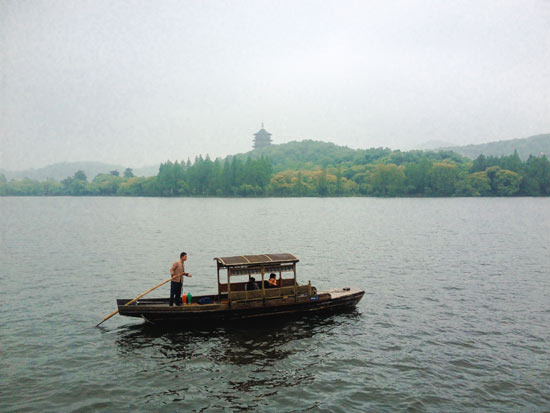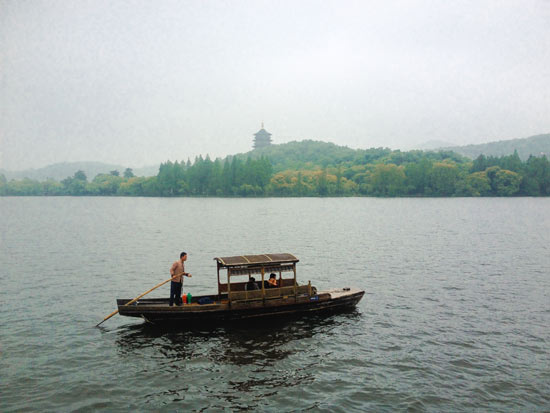The Amazing Tastes And Culture Of Hangzhou
Have you heard of Hangzhou? If you've never traveled to China or studied its geography, odds are you haven't. But don't feel bad: it's only a city of 8 million people, and by China's standards, that's no "big city." In the next few months, though, I'm willing to bet you'll start to hear more about Hangzhou than ever before, as it's been making a name for itself as one of China's most impressive culinary destinations. I had the chance to check it out in April, and on top of being a hungry traveler's happy place, it's remarkably clean and green, and in a country where even the most daring jetsetters have been known to encounter culture shock–a least a little–Hangzhou doesn't overwhelm, making it a great place to start if you're new to exploring the People's Republic.
Located roughly 110 miles southwest of Shanghai, Hangzhou is the capital of Zhejiang province and has prime position in the Yangtze River Delta near China's southeast coast. Since you'll likely fly into Shanghai (or at least spend several days visiting there on most excursions to China), taking a one-hour bullet-train ride from there to Hangzhou is an easy way to see contrasting Chinese lifestyles. The two cities are nearly as close to each other–yet even more different from one another–as NYC and Philly, with Hangzhou being decidedly more relaxed and full of nature compared to Shanghai, which is famed for clustered skyscrapers and notorious for enormous crowds.
To many Chinese, Hangzhou is known as China's "paradise city," and there are old proverbs proclaiming it as the best city to pick as a home if you had the luxury of choosing where to live centuries ago. Marco Polo is said to have been awed by its beauty, declaring that Hangzhou was "the finest and most splendid city in the world" roughly seven hundred years ago, around the time it served as China's capital during the Southern Song Dynasty. Today, you'll probably hear an updated pronouncement that compares Hangzhou to neighboring Shanghai: "For every five people in Shanghai, there's one tree; for every one person in Hangzhou, there are five trees." And it's no exaggeration. Before I left on this trip, a friend told me about experiencing unbearable air pollution in Beijing and Shanghai, and then I saw ominous, hazy skies for a chunk of the three-hour drive to my hotel in Hangzhou after arriving at Pudong Airport. But once Hangzhou's limits approached and we headed in, it looked as though the lush greenery had alleviated the local smog situation, a surprising amount of sycamores and willows shading the streets as my shuttle rode in.
At the moment, Hangzhou is mostly known for gorgeous landmarks showcasing ancient Chinese architecture and design, and for being the "Tea Capital of China" in the minds of many connoisseurs. And while there are droves of dark green and gray taxis, a subway line, and tons of sprawl in the form of twenty-five-story hotels, apartment buildings and offices to accommodate its millions of citizens and visitors, Hangzhou is the Kenny G to Shanghai's Slayer.
The city's scenic attractions have attracted travelers for years. Take West Lake (a UNESCO World Heritage Site), Hangzhou's version of Central Park, surrounded by thick, leafy trees and walking paths lined with wide-eyed tourists, its waters topped with immense dragon boats that give sightseeing cruises where you'll go iPhone-camera-crazy from the picturesque views of mountains and pagodas all around you. My friends who were with me said it's absolutely mystical to take a 6 a.m. jog there because it's serene, there's dew in the air, and you can see people meditating in the grass (unfortunately, I don't rise until at least a couple hours later, and then it's straight to the breakfast bar for soup dumplings–my favorite perk about Chinese hotels).
There's also Lingyin Temple, featuring multiple halls adorned with massive, copper Buddha shrines, statues of legendary kings and mythical creatures, and outdoor altars for burning ceremonial incense sticks (you're handed three upon admission). Walking up to Lingyin's entrance, there are equally awesome, immense carvings depicting pilgrims (and more Buddhas, of course) in the rocky hillsides and caves known as the Feilai Feng grottoes, another spot where photo-mania creeps into to everyone's system. And then there are the city's neighboring tea villages, where Longjing Tea, a.k.a. "Dragon Well Tea," and the famed Emperor Tea (considered by many aficionados to be the world's top green tea) is produced a mere twenty minutes from the bustle of downtown Hangzhou–and still done solely by hand. (See for yourself on this tea tour through China.) But recently, some major developments have ushered HZ into the glint of the world's gastronomic spotlight like never before.
Let's start with the recent opening of the Hangzhou Cuisine Museum, not the first in China, but now the largest of its kind. Imagine being in a gallery with glass showcases containing the most colorful, artistic-looking plates of food you've ever laid eyes on, but not being able to eat any because nothing is real. Even the brains with baby bok choy looks like something you could snarf, but unfortunately for your starving self, it's all made of rubber and plastic, and created with uncanny precision, meaning some replicas look better than the real dishes. Still, not everything is synthetic, as I whiffed something surprisingly ripe in one room decorated with what I thought were fake fish and duck carcasses hanging from a rope, but the foul odor of decaying fowl flesh and fish stated otherwise.
Everything at the museum is done in the spirit of preserving Chinese food history and culture, and in the case of the odorous hanging fish and ducks, it was about the preservation of protein preservation methods. It might sound weird–and that's because it definitely is–but examining tantalizing plastic food is more fun and interesting than it sounds, especially because you can learn about how certain dishes tie into Chinese folklore (more on that later). Once you finish walking through the exhibit halls, where you'll see models of everything from whole roasted pig to sauteed lotus roots and every dim sum ever steamed, baked or boiled, you can reward yourself with real versions of the inedible food you just gawked at. (There would be a lot of angry people with amped-up appetites if this wasn't the case. Just saying.)
The museum's on-site restaurant has a huge open kitchen, and before you get seated you can peer in and get lost in wonder, watching the cooks perform their duties with incredible aplomb. You'll be seated in a separate room at a large, round table affixed with lazy susan, which makes it much easier to share a traditional feast with Hangzhou's most heralded dishes–like Dongpo pork, beggar's chicken, and West Lake vinegar fish–with your whole posse. If you order duck, don't be surprised to see a beak on your plate (to beak or not to beak?). And if you order the West Lake vinegar fish, don't be afraid to bite into one of its sucked-on-Gobstopper-like eyeballs; the texture is worth experiencing at least once, and it's something you can brag about for the rest of your life if you do it. (And these days, the cool kids are all about bragging rights when it comes to eating weird foods, are they not?)
Another culinary distinction for HZ is that it's home to the only place in Mainland China to be named to Restaurant Magazine's illustrious list of "Asia's Top 50 Restaurants," 28 HuBin Road. Located inside the Hyatt Regency Hangzhou, the restaurant takes its name from the hotel's address (like many other Hyatt restaurants in China), and has an extensive selection of regional specialties that the kitchen prepares as painstakingly as possible. Dongpo pork (named after Su Dongpo, a scholar, poet, and man-of-many-talents from the Song Dynasty who was so fond of the dish, he had locals affix his name to it–a factoid I learned at none other than the Hangzhou Cuisine Museum) comes shaped like a ziggurat, giving it exceptional eye-appeal for a dish where plate presentation isn't typically a primary concern, and is stuffed with bamboo shoots and served with warm chestnut pancakes for optimal-bite assembly. Dragon Well shrimp, cooked with the lauded green tea leaves of the region, comes glazed in a light tea-flavored sauce accented with Shaoxing wine (also produced in the vicinity) and thickened with the slightest bit of cornstarch, and beggar's chicken is wrapped in lotus leaves and clay and roasted whole to keep all its juices from escaping, both dishes given the utmost care to stay true to the original preparations from centuries ago.
Perhaps the most exciting culinary draw in Hangzhou is Hefang Street, a place that attracts both tourists and locals for the festive mix of food. The place is stacked with street vendors selling everything from griddled scallion pancakes and sweet glazed dough sticks to taro-flavored bubble tea and deep-fried stinky tofu, and souvenir vendors who can carve an etching of your face onto a marble block to create a one-of-a-kind signature stamp, or twist you up a wire sculpture of an electric guitar in a matter of minutes. The Hefang Street area is more than just one block, and encompasses the entire section surrounding the street itself, including a narrow, food-devoted alley that branches off perpendicularly where you can score creepy-crawly treats like scorpion-on-a-stick and whole crab with chili sauce. There's also another street that splits off where you'll find Hangzhou's oldest pharmacy (where certain species of ginseng are sold for prices too obscene to mention) and a vibrant open-air market where you can get a lifetime's worth of exotic eating experiences in one evening.
With more great chefs being drawn to this beautiful destination today than ever before, and the powers-that-be intent on developing the city's food tourism scene further, Hangzhou is poised to become a top draw for travelers who want to see, experience and taste China, but without the intimidating mobs and air pollution of its more popular cities. And these highlights are just the beginning. Stay tuned: you'll be hearing a lot more about this burgeoning culinary hot spot in the months and years to come.

